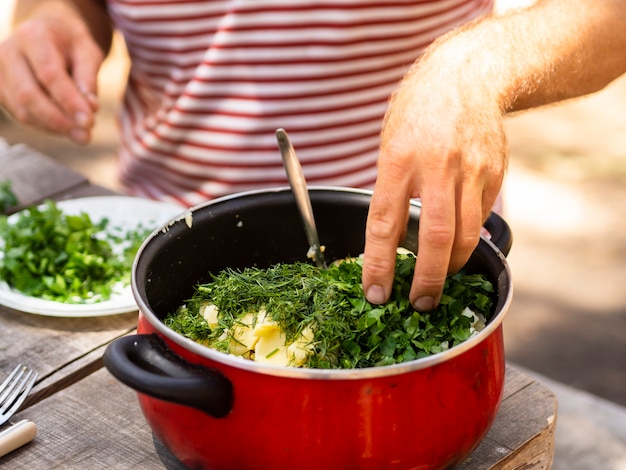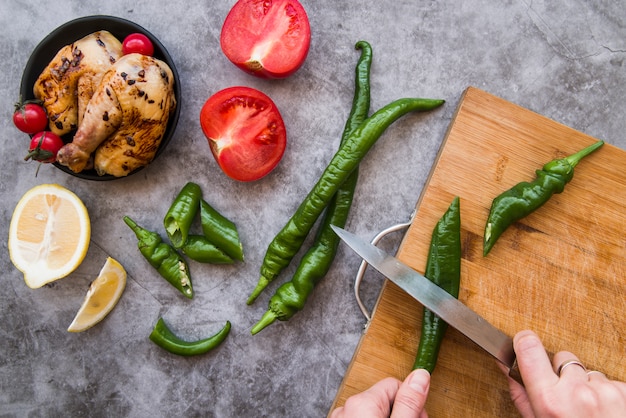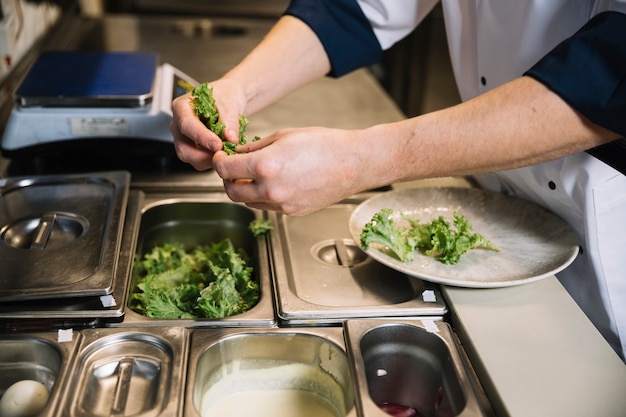Asparagus. Just the name evokes a sense of spring, freshness, and perhaps, a touch of culinary intimidation. It always feels fancy, a vibrant green statement on a plate that elevates any meal. But for years, I shied away from asparagus, worried about overcooking it. I've experienced my fair share of limp, mushy spears, which, let's face it, are a culinary tragedy. Then, I discovered the magic of the stovetop – a simple method that delivers perfectly cooked asparagus, every single time. So ditch the oven, grab your favourite pan, some beautiful asparagus, and let's embark on this delicious journey together.
Part 1: The Asparagus Shopping Spree

The first step to perfect asparagus is choosing the right spears. Think of it as a shopping spree at the greengrocer's, where you're picking the most stunning, vibrant specimens.
Seeking the Perfect Spears
When I'm selecting asparagus, I look for these key characteristics:
- Firmness and Crispness: Give the spears a gentle squeeze. They should feel firm, not limp or floppy. Think of them like a well-toned asparagus athlete, ready for action.
- Vibrant Green: Avoid any spears that are yellowed, discolored, or have wilted tips. You want a bright, fresh green that screams "eat me!"
- Uniform Thickness: Choose spears that are roughly the same thickness. This helps ensure even cooking, meaning each bite is equally delicious.
- Tightly Closed Tips: asparagus tips should be tightly closed, not open and spreading. This indicates freshness and quality.
You know how we always think "skinny is better"? Well, I've learned that thicker asparagus spears can actually be tastier, holding up well to different cooking methods. Don't be afraid to ask the greengrocer for their recommendations. They're the experts, after all! They'll steer you towards the season's best asparagus, ensuring you get the most delicious bounty.
Part 2: Prepping for Perfection

You've got your asparagus. Now it's time to prepare them for their culinary debut. Think of this as their backstage prep, getting them ready to shine on the stovetop stage.
Trimming the Woody Ends
Asparagus needs a little trim before cooking. The woody ends are tough and unpalatable, a bit like those awkward moments at a party you'd rather forget. The best way to trim asparagus is to snap it in half. Hold the spear by the tip and bend it gently. It will naturally break at the point where the woody stem begins. This is a neat trick that nature provides, giving you perfect, tender spears. If you prefer a more precise approach, you can use a sharp knife to cut the ends off.
Washing and Drying: A Crucial Step
After trimming, it's time for a quick spa treatment. Rinse your asparagus under cold water to remove any dirt or debris, ensuring they're sparkling clean. Then, pat them dry thoroughly with a kitchen towel. Water can lead to steaming instead of sautéing, resulting in mushy, sad spears. We want our asparagus to be crisp and vibrant, ready to sing with flavour.
Part 3: The Stovetop Symphony

This is the heart of the recipe – the moment where your asparagus transforms from simple spears into a delicious dish. Let's dive into the stovetop symphony.
The Stovetop Method: Simple, Yet Effective
I used to be a devoted fan of oven-roasted asparagus. But then I discovered the magic of stovetop cooking, and my culinary world was forever changed. It's simpler, faster, and delivers that perfect texture I crave.
- Heat Your Pan: Start by heating a large skillet or frying pan over medium-high heat. This creates a hot canvas for your asparagus to cook beautifully. You can feel the anticipation building, just like the first notes of a symphony.
- A Little Oil is Key: Add about a tablespoon of olive oil or your favourite cooking oil to the hot pan. You should hear the oil sizzle as soon as it hits the pan, a delightful sound that tells you it's ready for the asparagus.
- Enter the Asparagus: Now, add your asparagus to the hot pan, spreading them out in a single layer. They're ready for their star turn, and this single layer ensures they cook evenly.
- Cook for a Few Minutes: Cook the asparagus for about 3-5 minutes, tossing occasionally, until they are bright green and tender-crisp. You want them to retain their vibrant colour and have a slight bite. This is the key to perfection – not overcooked, not undercooked, just right.
I prefer my asparagus slightly tender, with a slight bite. It's like a good conversation – you want to feel engaged, not overwhelmed. If you prefer a more cooked asparagus, you can continue cooking for a few minutes longer. The beauty of this method is that you're in control, and you can customize it to your taste preferences.
Part 4: A Symphony of Flavors
Now, the fun part! It's time to add the finishing touches, the seasonings that will transform your asparagus into a culinary masterpiece.
Simple Yet Stellar: Salt and Pepper
Sometimes, the simplest seasonings are the most effective. A sprinkle of salt and black pepper enhances the natural flavour of the asparagus, letting it shine. I love using a good quality sea salt and freshly ground black pepper for that extra oomph. It's like adding a touch of elegance to a simple melody, elevating the overall experience.
Lemon Juice: A Bright and Zingy Touch
A squeeze of fresh lemon juice is a classic flavour enhancer, adding a touch of acidity that perfectly balances the sweetness of the asparagus. Think of it as adding a refreshing flute to the orchestra, bringing a bright and zingy element to the composition.
Garlic and Herbs: Savoury and Aromatic
For a more complex flavour profile, try adding garlic and herbs. I love adding a clove of minced garlic to the pan with the asparagus, then stirring in some fresh herbs like parsley, dill, or chives towards the end of cooking. This creates a symphony of savoury and aromatic notes, a true culinary delight.
More Flavourful Ideas: Expanding Your Palette
Asparagus is a culinary chameleon, embracing a wide range of flavour combinations. Here are some other ideas to spice things up:
- Smoked Paprika: A pinch of smoked paprika adds a smoky depth to the asparagus, like adding a sultry saxophone to the orchestra, adding a rich, smoky dimension.
- Red Pepper Flakes: For a touch of heat, a sprinkle of red pepper flakes brings a fiery element to the mix, just like a vibrant trumpet solo.
- Soy Sauce: A dash of soy sauce adds a salty, umami flavour, creating a savoury bassline to the culinary melody.
- Toasted Sesame Seeds: For a nutty crunch, sprinkle some toasted sesame seeds on top. It's like adding a percussion section, adding a delightful textural element to the dish.
Part 5: Beyond Basic Cooking: Mastering Different Techniques
You've mastered the stovetop method. Now it's time to explore other techniques, to expand your culinary repertoire and embrace the versatility of asparagus.
Roasting: Crispy and Delicious
If you're after a crispy texture, roasting asparagus in the oven is a fantastic option. Preheat your oven to 400°F (200°C), toss the asparagus with olive oil and your favourite seasonings, and roast for 10-15 minutes, until tender-crisp and slightly browned. It's like creating a crispy, caramelized layer, adding another layer of texture to your asparagus symphony.
Grilling: Smoky and Flavorful
grilling asparagus is a delightful way to add a smoky flavour. Preheat your grill to medium heat, toss the asparagus with olive oil and seasonings, and grill for 5-7 minutes, turning occasionally, until tender-crisp and lightly charred. The grill marks add a delightful visual element, while the smoky flavour adds a new dimension to the culinary experience.
Blanching: Quick and Easy
Blanching asparagus is a quick and easy method for cooking it. Bring a large pot of salted water to a boil. Add the asparagus and cook for 2-3 minutes, until bright green and tender-crisp. Drain the asparagus and immediately plunge it into a bowl of ice water to stop the cooking process. This is a perfect option for a quick side dish or for incorporating asparagus into other recipes.
Part 6: Asparagus: A Versatile Side Dish
Asparagus shines as a side dish, adding a vibrant touch to any meal.
A Classic Companion to Dinner
A plate of perfectly cooked asparagus is the perfect accompaniment to a roasted chicken, grilled salmon, or a juicy steak. It brings a burst of freshness and lightness to any protein-heavy dish, adding a delightful counterpoint to the richness of the main course.
Lighter Options for Lunch
Asparagus is also a wonderful addition to lighter lunches. Serve it alongside grilled fish, a simple salad, or a hearty soup. Its delicate flavour and vibrant colour elevate any lunchtime dish, making it feel special and satisfying.
Part 7: Asparagus: Beyond the Sidelines
Asparagus isn't just a side dish; it's a versatile ingredient that can elevate countless dishes.
A Refreshing Addition to Salads
Asparagus adds a delicious crunch and earthy flavour to salads. Toss it with your favourite greens, vegetables, and dressing for a satisfying and healthy meal. It adds a textural element and a fresh burst of flavour, transforming your salad from ordinary to extraordinary.
Enriching Soups and Stews
Asparagus can also be added to soups and stews for a unique flavour. I like to add it to a creamy tomato soup or a hearty minestrone. It brings a delicate sweetness and a beautiful green hue to the soup, enhancing the flavour and visual appeal.
A Delightful Pasta Partner
Asparagus is a wonderful addition to pasta dishes. Toss it with cooked pasta, garlic, and olive oil for a simple and delicious meal. It creates a light and flavorful pasta dish, adding a touch of elegance to an everyday meal.
A Star Ingredient in Quiches and Frittatas
Asparagus adds a lovely flavour and texture to quiches and frittatas. Slice it into thin pieces and add it to the mixture for a delicious and satisfying brunch or dinner. Its subtle sweetness and delicate texture complement the richness of the quiche or frittata, creating a harmonious culinary experience.
Part 8: Storing and Freezing Asparagus: Preserving the Freshness
You've brought your asparagus home, and now it's time to ensure its freshness and longevity.
Refrigerator Storage: Keeping Asparagus Fresh
To keep asparagus fresh, store it in the refrigerator in a plastic bag or container. Place a damp paper towel in the bag to help prevent the asparagus from drying out. Ideally, store asparagus in the crisper drawer, where it'll be kept cool and moist.
Freezing Asparagus: Saving the Bounty
You can also freeze asparagus to enjoy it later. To freeze asparagus, trim the ends, wash and dry the spears, and blanch them in boiling water for 2-3 minutes. Then, drain the asparagus and plunge it into ice water to stop the cooking process. Once the asparagus is completely cooled, spread it out on a baking sheet and freeze until solid. Then, transfer the frozen asparagus to a freezer-safe bag or container. Frozen asparagus can be used in soups, stews, and other cooked dishes, ensuring you have a delicious supply throughout the year.
Part 9: FAQs: Answers to Common Asparagus Questions
Here are some frequently asked questions about asparagus, addressing any lingering doubts or curiosities you might have:
1. How Long Does Asparagus Last?
fresh asparagus will last for 3-5 days in the refrigerator if stored properly, giving you enough time to enjoy it.
2. How Can I Tell if Asparagus is Bad?
Asparagus that is past its prime will have a yellowed or discoloured appearance. The tips may be open and spreading. It will also feel limp and mushy.
3. Can I Eat the White Part of Asparagus?
Yes, you can eat the white part of asparagus, but it's often more fibrous and less palatable. Most people trim it off, focusing on the tender, delicious green portion.
4. What's the Difference Between Green and White Asparagus?
Green asparagus is harvested when the spears have emerged from the ground and have been exposed to sunlight, giving it its vibrant green color. White asparagus is harvested before it emerges from the ground. It has a milder flavour than green asparagus, due to its lack of exposure to sunlight.
5. What Are Some Health Benefits of Asparagus?
Asparagus is a good source of vitamins, minerals, and antioxidants. It's also low in calories and fat. Adding asparagus to your diet can provide a boost of nutrients, promoting overall well-being.
Now you're equipped with all the knowledge to become an asparagus maestro, cooking perfect spears with ease and confidence. Embrace the versatility of this spring vegetable, and enjoy its fresh, vibrant flavour in countless dishes!
Everyone is watching

How to Cook Frozen Lobster Tails Perfectly: A Step-by-Step Guide
RecipesLobster. Just the word conjures up images of lavish meals, special occasions, and a taste of luxury. But let's...

Pigs in a Blanket Cooking Time: How Long to Bake for Perfect Results
RecipesAh, pigs in a blanket. Just the name conjures up images of those delightful little parcels of crispy pastry en...

Pork Fillet Cooking Time: How Long to Cook It Perfectly
RecipesPork fillet, or tenderloin as it's sometimes called, is a real favourite in our house. It's so versatile, and...

The Ultimate Guide to Tender, Juicy Pulled Pork
RecipesRight, let's talk pulled pork. It's one of those dishes that just screams "comfort food," doesn't it? I mean...

The Ultimate Guide to Cooking Delicious Frankfurters
RecipesLet's face it, we all love a good frankfurter. It's a classic, simple, and always satisfying. But let's be rea...
